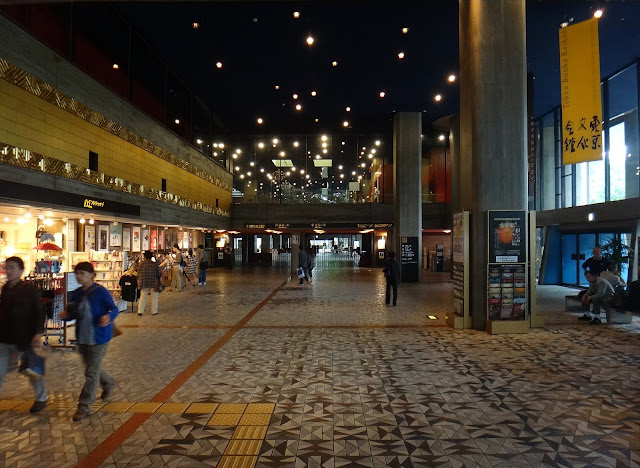- Get link
- X
- Other Apps
Featured Post
- Get link
- X
- Other Apps
 |
| Front of Tokyo Bunka Kaikan: notice the blue and red doors similar to Le Corbusier's Unité d'Habitation in Marseille image credit nova68.com. |
 |
| Tokyo Bunka Kaikan building by Kunio Mayekawa 1961 image credit nova68.com. |
 |
| Detail of concrete panels on the right of front entrance image credit nova68.com. |
 |
| Tokyo Bunka Kaikan celebrates it is 50th anniversary without much attention (without the small sign, nobody would know) image credit nova68.com. |
 |
| Stunning architectural detailed walls both inside and outside. |
 |
| Decorative rocks were placed one by one, beautiful composition. |
 |
| Beautiful modernist waterway and sculpture image credit nova68.com. |
 |
| Closer detail of sculpture image credit nova68.com. |
 |
| Closer detail of sculpture (front view) image credit fotopedia. |
 |
| Main entrance hall (notice wall and floor design + Sarfatti chandeliers in the back) image credit nova68.com. |
 |
| Detail of the modern floor tile pattern (runs throughout the building). |
 |
| Lights seem to have been placed at random to give the impression of a star-filled night's sky image credit nova68.com. |
 |
| Ground floor at rear of building image credit nova68.com. |
 |
| People give a sense of the massive scale and space of this building image credit nova68.com. |
Architecture by Kunio Mayekawa
Tokyo Bunka Kaikan, Tokyo Japan
This article is about Kunio Mayekawa (1905-86) and his spectacular but rather unknown modernist landmark, the Tokyo Bunka Kaikan (translates to Tokyo Cultural Center) building which currently houses the Tokyo Metropolitan Symphony Orchestra). Constructed in 1961, this year marks the 50th anniversary. We had a unique chance to tour this architecturally significant masterpiece which is located in Ueno Park, smack right in the center of Tokyo Japan. We were blown away with the sense of detail and balance. This building is truly spectacular and a delight for fans of modern architecture. What makes it extra special is that it has survived the last 50 years reasonable unscratched and most of the original features have remained unchanged. Right across from Tokyo Bunka Kaikan is another master piece: Le Corbusier's National Museum of Western Art Tokyo (1959). Japan has been trying to get Le Corbusier museum listed on UNESCO's World Heritage listing, so far unsuccessfully. That is an obvious mistake since the lesser known Tokyo Bunka Kaikan by Kunio Mayekawa is in fact the great undiscovered masterpiece they have been sitting on without realizing it. Tokyo Bunka Kaikan has a much greater chance to receive UNESCO's World Heritage distinction.
Kunio Mayekawa is the often forgotten but pivotal master of modern architecture in Japan. Arguably the greatest modernist architect in Japan since he was the one who tutored Kenzo Tange. Kunio Mayekawa AKA Kunio Maekawa (前川 國男) was one of the leading founders of the Japanese modern architecture movement during the middle of the 20th century. Kunio Mayekawa worked and studied under Le Corbusier in Paris between 1928 and 1930 and the influence from Le Corbusier would be clearly visible in many of Kunio Mayekawa's works in Japan. Note the blue and red door on the front of the building, a nice little touch which reminds us of the work of Le Corbusier.
 |
| Tokyo Bunka Kankan symphony hall. |
Kunio Mayekawa was one of the first in Japan to adopt rational architecture. During the 1950's and 1960's Kunio Mayekawa designed sculpturally expressive modern architectural structures by combining national traditions with the structural and aesthetic possibilities of reinforced concrete. Kunio Mayekawa designed many public buildings, including municipal buildings in Fukushima (1958) and Hirosaki (1964); cultural centers in Tokyo (1959), Kyoto (1960), Okayama (1962), and Urawa (1966); and the Gakushuin University in Tokyo (1960). He also created prefabricated structures and high-rise apartment buildings in Japan.
Prominent among modern Japanese architects, Kunio Mayekawa is one of the most notable architects of Japanese Mid Century Modern Architecture together with Kenzo Tange and Sakakura Junzo.
Tokyo Bunka Kaikan
東京都台東区上野公園5−45
110-0007, Japan
前川國男
前川 國男(まえかわ くにお、1905年5月14日 - 1986年6月26日)は日本の建築家である.
ル・コルビュジエ、アントニン・レーモンドの元で学び、モダニズム建築の旗手として、第二次世界大戦後の日本建築界をリードした。丹下健三、木村俊彦は前川事務所の出身であった.
近代建築を最初に生み出した西ヨーロッパからみれば後進的であった日本に、真正の近代建築を根付かせるという使命を自らに課すことから出発した前川國男は、日本と日本建築界は当時の先進地域と同水準の技術的な土台、経済的下部構造または生産の社会的諸条件を備えるべきであり、もしそれが先行あるいは並行して実現されなければ、日本の近代建築は見せかけだけの偽物にとどまるしかないであろうと考えた.
資材統制が終わった1950年代に前川は「日本相互銀行本店」をはじめとする諸作品によって「テクニカル・アプローチ」の範を示し、日本における近代建築の技術的諸課題の克服に直接的かつ間接的に寄与した.
しかしその設計作品は、初期および中期においてさえ、均等ラーメン構造、工業化、機能主義等によって特徴付けられる(いわゆる国際様式の)単なる近代建築というよりは、「光の下で組み合わされた諸々のヴォリュームの巧緻精確で壮麗な遊戯(ル・コルビュジエ)」とみなすことができ、人間的な尺度と民俗的または土着的な温かみを兼備している.
1960年代半ば以降、前川は産業社会とそれを支える合理主義のいくつかの側面にきわめて批判的になったが、近代運動の理想の最良の部分を最後まで放棄しなかった. なによりも強調するべきことは、前川はその生涯を通し建築家の職能と職業倫理の確立のために尽力したと言い得る.
architects
architecture
architecture in japan
buildings
icon
japan
japanese architecture
japanese design
mid century architecture
tokyo
- Get link
- X
- Other Apps